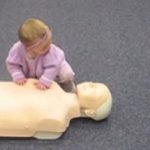Are You Trained In CPR? Only 3.5 Percent Of People Are Each Year
 If you or someone you love suffers from a cardiac arrest emergency, the chances that someone nearby knows the lifesaving technique you require are very slim. Only 3.5% of people are trained each year in CPR, and that number becomes even lower in rural areas. CPR, also known as Cardio Pulmonary Resuscitation, is a technique that requires training so that if you come across a victim of cardiac arrest then you can use this technique to save the victim’s life. CPR can be used to revive people who are not breathing, do not have a pulse or are unconscious.
If you or someone you love suffers from a cardiac arrest emergency, the chances that someone nearby knows the lifesaving technique you require are very slim. Only 3.5% of people are trained each year in CPR, and that number becomes even lower in rural areas. CPR, also known as Cardio Pulmonary Resuscitation, is a technique that requires training so that if you come across a victim of cardiac arrest then you can use this technique to save the victim’s life. CPR can be used to revive people who are not breathing, do not have a pulse or are unconscious.
Dr. Monique Anderson, a Duke cardiologist, had been speaking at the American Heart Association Conference in Chicago when she and a colleague returned to their hotel. As they returned to the hotel and the elevator doors opened they saw a man face down and unconscious on the floor. “There was this gentleman face down, and I think both of us looked at each other, briefly asking ourselves if what we were seeing was real,” Dr. Monique Anderson recalled.
Her colleague was a cardiologist named Dr. Eric Peterson, who quickly called 911 while Anderson took all of the necessary steps to begin CPR. When she did begin she used a method called hands-only CPR, which means 100 compressions per minute, two inches deep. “And it wasn’t long after that he started moaning and sat bolt upright and said he’s OK,” she said. Shortly after the man regained consciousness an EMS crew arrived. “We know that for every minute that passes when a person is collapsed, there’s a decrease in survival of about 10 percent,” Anderson said.
A study about CPR Readiness was conducted at Duke University and referenced at the conference Dr. Monique Anderson and Dr. Eric Peterson had been speaking. The study showed that the rates of bystander CPR have improved over the past four years from 40 percent of patients who need CPR and are administered CPR successfully by a bystander, to 5o percent of patients. This is an improvement but it still means you only have a 50/50 chance of surviving if you become a victim, and remember in rural areas these numbers are even lower. “Really all adult Americans without any limitations should know CPR and should know hands-only CPR, because you just never know when something like this will happen,” Anderson said.


